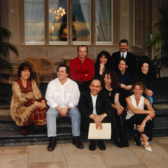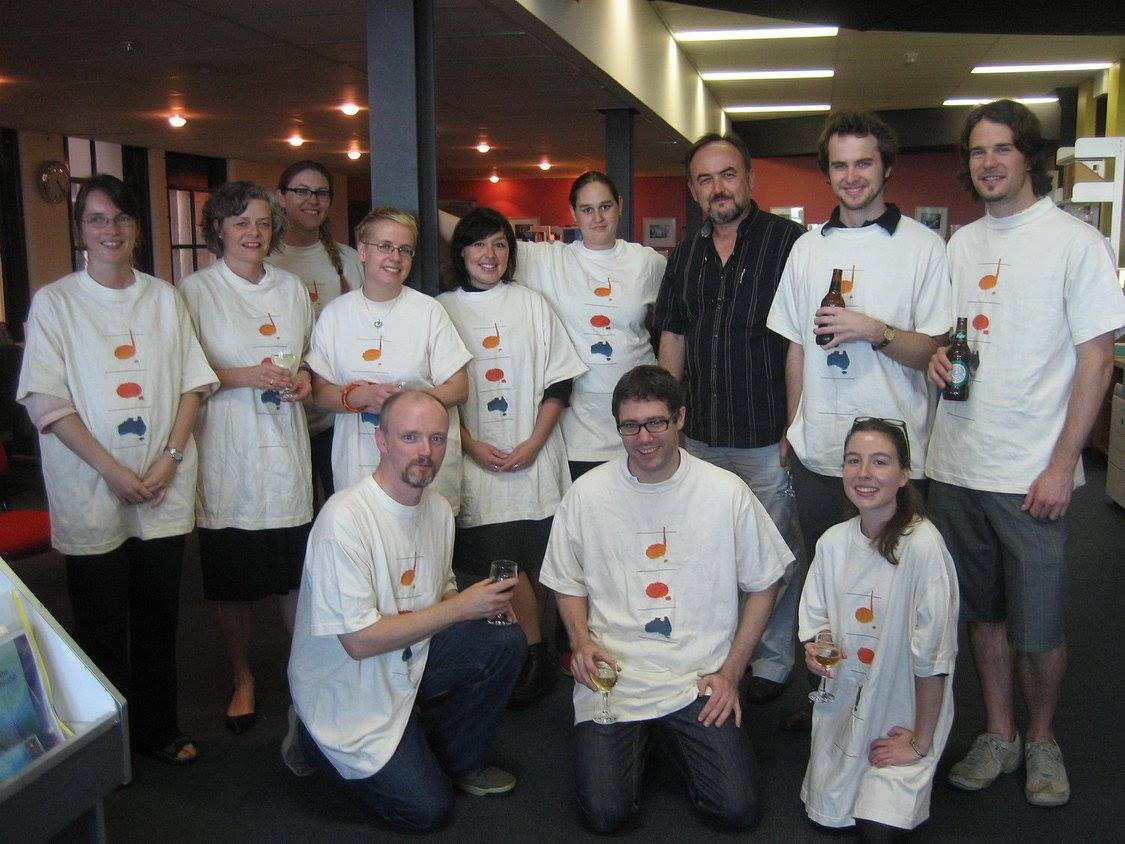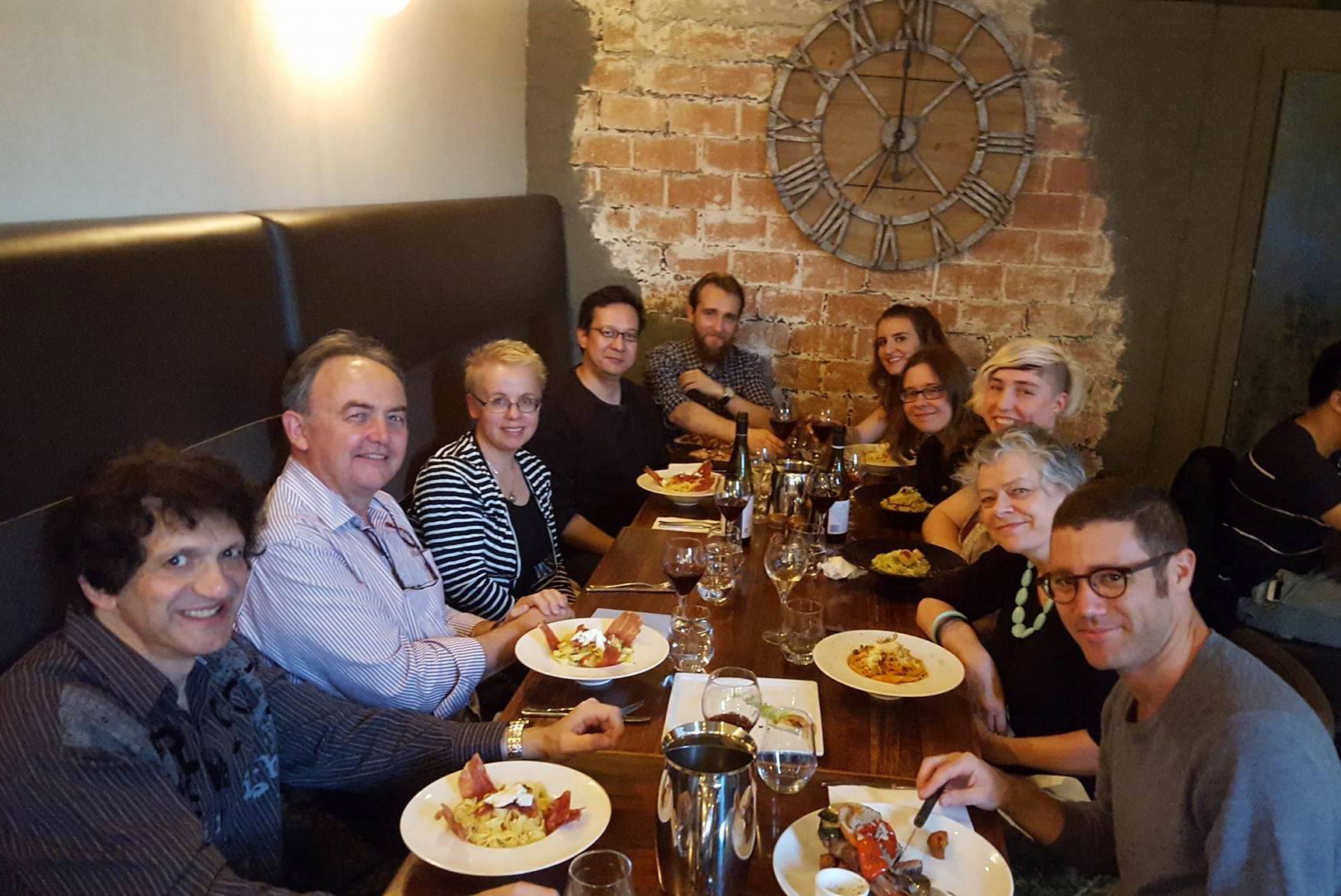28 October 2025
With Open Ears and Open Eyes, An Open MInd and an Open Heart
Personal Reflections on the AMC's 50th
 Image: AMC Staff, 1996-97, Government House
Image: AMC Staff, 1996-97, Government House As part of the AMC's 50th year celebrations, I was invited to reflect on my 32 years working with the organisation. These six questions provide a framework to look back on how both the AMC and the art music sector evolved during that time.
For a fuller historical account, I recommend the timeline prepared for the AMC's 40th anniversary in 2015: https://www.australianmusiccentre.com.au/about/AMC40
1. Introduce yourself and your relationship with the AMC.
I'm John Davis. I joined the AMC in 1989 as a junior sales assistant, later became Sales and Repertoire Manager, and was appointed General Manager in 1995. In 2008, my role was reclassified as CEO. I remained in that position until 2021.
2. How did you first become involved with the AMC (and how did your involvement evolve)?
My first encounters with the AMC were as a student. In the late 1970s I visited the library to listen to the extensive collection of Australian jazz recordings held then. Later, while studying composition in the 1980s, I spent hours exploring the collection of scores, recordings, and composer files, developing an understanding of the Australian musical landscape.
In 1989 I was offered a role at the AMC, in the rapidly expanding commercial arm under Lorna Lander, creating catalogues and promoting repertoire. It was a vibrant time: Richard Letts was expanding activities under the Sounds Australian banner, commissioning, publishing, and promotional projects. When Cathy Brown Watt succeeded him in 1993, she brought refocussed financial and governance systems.
By 1995 she had moved to the Australia Council, and I was encouraged to apply for the General Manager position. I was appointed in June that year and remained in leadership for the next 26 years.
I want to acknowledge the philosophical foundations of the organisation laid down by my predecessors, in particular founding Director James Murdoch, Dick Letts, and Cathy Brown-Watt, whose still-relevant, meaningful legacies, have helped to shape the organisation over time, and this also shaped my time at the helm of the AMC too.

3. Can you tell us about a project or initiative held by the AMC that was particularly meaningful for you?
It's impossible to single out just one. The AMC changed enormously during my time, shaped both by internal decisions and external pressures. Five areas stand out that mean a great deal to me:
Digital expansion. When I arrived, there was one computer in the office and typewriters on most desks. By 2000 the AMC committed to digitising its collection and moving online - a radical, risky decision at the time, but one that transformed the organisation and opened up far broader access to Australian music. With the input of amazing staff under guidance from Simon Chambers, and through collaboration with the NLA and international colleagues, the AMC built a pioneering online system that became a global benchmark for how Music Information Centres might operate in the online environment.
International advocacy. Advances in communication made global networks possible, and the AMC embraced them. We hosted the IAMIC conference in 1999 and the ISCM World New Music Days in 2010. These activities created relationships that boosted Australian visibility abroad and created pathways for our composers and performers. I also had the privilege of serving on the IAMIC Board and various iterations of the ISCM Executive Committee, including as ISCM President from 2008-2013. Later the partnership with APRA and Sounds Australia encouraged pathways for Australian artists to engage with networks through major international industry showcase events - Classical:NEXT, and jazzahead!.
Art Music Awards. Evolving from the much earlier AMC awards and Sounds Australian Awards, our partnership with APRA since 2003 has built the Art Music Awards into a major annual celebration. Beyond providing a showcase for Australian art music, the event strengthens community identity and provides visibility to diverse creative practice.
Collaboration and partnership. The AMC's relevance and success has always depended on relationships-with APRA, the National Library, ABC, AMEB, education sectors, publishers, and record labels. Collaborating widely, including with competitors, has been essential to supporting the ecosystem. These relationships have also provided the AMC with knowledge, and tools to identify and address issues affecting the sector.
Diversity and inclusion. From early attention in the 1990s to gender representation, to later initiatives like Ngarra Burria for First Nations composers, the AMC has continually worked to broaden whose voices are heard. This has been challenging, ongoing work, never easy, but it remains essential to mapping and nurturing Australia's continually evolving cultural landscape.
4. In your view, what impact has the AMC had for the art music community in Australia?
For some, the AMC has been a practical lifeline - publishing scores, making repertoire available to performers and educators. For others, it has been a reference point: a place to discover artists, works, and opportunities. Increasingly, the online platform has provided a mapping of Australian art music in all its complex diversity. And for yet others, it's been purely about increased awareness of, and the imperative to, represent the Australian option.
But the AMC's role has gone beyond services. It has also been about leadership-though not in the sense of setting agendas from the front. I've always thought of it as leadership from behind: creating frameworks where others can thrive, providing platforms for voices to be heard, and facilitating conversations across a sometimes fragmented community. It's highly nuanced. It's about "bearing witness", approaching everything with open ears and open eyes, an open mind and an open heart.
Directly tied to this is the AMC forging and nurturing relationships, built on ongoing conversations and collaborations, developing trust over time with key stakeholders and beyond. This is such an important part of its leadership responsibilities, being connected and relevant.
From a governance
perspective, we know from
a number of prominent recent examples
that there are huge challenges in how leadership and governance
structures function in the cultural
sector (including
funding bodies), and the
not-for-profit sector
more broadly. How leadership
is demonstrated
in these
governance structures is not determined
by templates
or hard
and fast rules. Volunteer boards are
expected to oversee appropriate
management of an organisation and
ensure its well-being, individuals bringing their
particular experience and expertise
and perspective
to the table - which may not always embrace the complexities of a
complex community with many competing interests.
It's
a challenge for
any organisation to have a positive impact in the
community that it serves, and navigate successfully
through troubled
waters, unless there
is strong
cohesion and trust between a governing board, its staff, and its
constituents. It requires ongoing scrutiny by everyone, ongoing
consultation and awareness, things which are not always possible
to get exactly right, mistakes are often made.
It's
an imperfect
system, but one that necessarily
has to be
embraced.
5. What do you love about being a part of the art music community in Australia?
I never cease to be amazed by the breadth and vitality of this community. For me, a map of Australia is not just geography but a constellation of people, organisations, and creative activity. It is a landscape of landmarks, alive with stories, constantly evolving, and endlessly inspiring.
6. What do you hope for the future of Australian art music?
Well…, Nick Cave writes that hope is optimism with a broken heart, hope has an earned understanding of the sorrowful or corrupted nature of things, yet it rises to attend to the world even still.
So, in that spirit, I hope that art music continues to flourish, and that new work continues to always evolve, and explore the furthest new horizons. I do however fear for the future of funding support for art music practice, especially of the more innovative practice outside the mainstream, where increasingly blurred lines arise between funding support for making art that stretches boundaries and tests limits, alongside funding investment in endeavours that have some potential for commercial sustainability. It's a difficult line to walk. Finding an appropriate balance between these is critical to the survival of art music. It is vital that the diversity in the art music sector continues to expand rather than contract, because that's what appropriately reflects the diversity in contemporary Australian society, and cultural expression.
And to hope more than this, the leadership responsibilities I spoke of earlier apply here as well, to every artist, practitioner, teacher, artsworker, and music supporter. If we have a community where individuals exercise "good citizenship", taking on these leadership principles: embracing collegiality and mutual support; tolerance, and appreciation of difference; individuals developing an ever-evolving understanding of the artform as whole rather than just from a specific viewpoint - then we really have something meaningful and worthy, something really powerful, and something we can really take pride in.

Photo: Staff 2016 (L-R): Adrian Lucca, John Davis, Anni
Heino, James Lee, Thomas Krizanec, Rebecca Cernec, Liz Jigalin,
Jane Aubourg, Judith Foster, Simon Chambers.
Closing reflections
The AMC's work has always been guided by what we used to call the "four G's": Geography, Gender/Inclusion, Genre, and Generational representation. These principles helped shape decisions, but ultimately it has been people-staff, artists, and the AMC's broader constituents - who made the organisation what it is.
Looking back, I feel the AMC's greatest strength has been its ability to adapt, to listen, and to hold space for a community that is complex, diverse, and ever-changing. I am grateful to have been part of that journey, and to share it with the AMC's always-amazing staff, who certainly during all my time with AMC truly shaped the organisation in amazing ways, supporting me, embracing the organisation's mission, and working tirelessly on behalf of it - they have always been the AMC's greatest asset.
© Australian Music Centre (2025) — Permission must be obtained from the AMC if you wish to reproduce this article either online or in print.
Australian Music Centre
Comments
Be the first to share add your thoughts and opinions in response to this article.
You must login to post a comment.